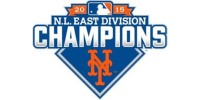Michael Conforto
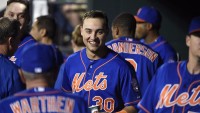
Watching the Mets lose the 2015 World Series was tough. There were a lot of what-if moments. The Mets lost three ninth inning leads. There was a lot to get you down.
However, there was one at bat from that entire series that made me smile. The funny thing was the at bat had no bearing on the outcome of any of the World Series games. It was the penultimate at bat of the World Series.
Michael Conforto stepped up to the plate against Wade Davis. The Mets were down 3-1 in the series. Davis has a career 0.84 career postseason ERA, and he had not allowed a run in the 2015 postseason. The Royals were leading 7-2 in the 12th inning. There were two outs, and Davis had two strikes against Conforto. There wasn’t going to be any rallies reminiscent of the 1986 World Series. It was over, and the only issue in doubt was who was going to become the answer to a trivia question for making the last out of the World Series.
It wasn’t going to be Comforto. He would hit an opposite field single. In a World Series where he hit two home runs in a game, I was most impressed with this at bat. It spoke to what he was as a player. He was never going to quit despite mounting odds. It showed how special he was going to be.
Unsurprisingly, Conforto picked up where he left off. On Opening Day, he went 2-2 with a double and two walks. On a day where the Mets hitters struggled, Conforto couldn’t make an out. It was yet another sign that he is a special player. There may be no limit to what he can accomplish. From an offensive standpoint, it’s hard not to compare him to another player who skipped AAA to star in the majors.
In 2003, Miguel Cabrera skipped AAA, and he was called up to the majors to play left field for the Florida Marlins. He was the missing piece for the eventual World Series champions. That year, he hit .268/.325/.468 with 12 homers and 62 RBI in 87 games. He had a 106 OPS+, 106 wRC+, and a 0.6 WAR. He notably hit a homerun off of Roger Clemens in the World Series.
Cabrera would go on to win a Triple Crown, two MVP Awards, and six Silver Slugger Awards. He’s a 10 time All Star. He’s a future Hall of Famer.
Last year, Conforto played in 56 games hitting .270/.335/.506 with 9 homers and 26 RBI. He had a 132 OPS+, 134 wRC+, and a 2.1 WAR. As discussed before, he hit two homeruns in a World Series game. When he hit the first homerun, he became the youngest player to homer in the World Series since Cabrera. Furthermore, he has shown himself to be a good left fielder with a strong, accurate arm. Overall, to this point in his brief career, he’s been better than Cabrera.
Also of note, Conforto is a winner wherever he goes. He’s the third player to appear in the Little League World Series, College World Series, and the World Series. He’s the only person to record an RBI in all three World Series. There is no stopping Michael Conforto.
Cabrera went on to become one of if not the best hitter in the sport. The scary part is Conforto was better than Cabrera was at this point in his career. Judging by the first game of the season, Conforto is not taking anything for granted. He’s going to do everything he can do to unlock his full potential. That could mean All Star games, Silver Sluggers, and possibly MVP awards. Hopefully, there will be at least one World Series title.
Right now, the sky is the limit for Conforto. We shouldn’t be surprised at what he accomplishes.
Editor’s Note: this was also published on metsmerizedonline.com
* picture from the Mets Twitter account
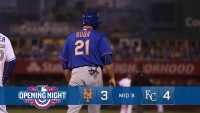
Aside from the fact that Curtis Granderson didn’t hit a homerun, Opening Day sure felt like a repeat of the 2015 World Series. As the late Yogi Berra would say, “It’s déjà vu, all over again.” We had the following:
- Yoenis Cespedes failing to make a routine play in the outfield leading to a run;
- A good Matt Harvey effort getting wasted;
- The Royals taking advantage of a poor Mets defense;
- Michael Conforto being really impressive; and
- The Mets losing.
For all the debating over the course of the offseason regarding Terry Collins leaving in Harvey, we got a taste of what Game 6 would’ve looked like. It wasn’t pretty. It really highlighted what the Royals did well, and the Mets did poorly.
The main difference between these teams is fundies (as Keith Hernandez puts it), defense, and a little bit of luck. Cespedes drops an easy out off the bat of Mike Moustakas, and he later scores on a single past Asdrubal Cabrera, who showed off his limited range at short on the play. Eric Hosmer‘s bunt stays fair while Juan Lagares‘ goes foul. Yes, it would lead to a run. Alex Gordon hits one off the end of the bat falling just out of the reach of Lagares to score a run. It was as frustrating as the World Series.
Since the Mets lost, let’s start with the bad. Mainly, it was David Wright. He couldn’t hit a fastball. He was 0-4 with a walk and two strikeouts. The last strikeout was in the ninth with the tying run on third. He made a couple of plays in the field, but he was able to get absolutely nothing on his throws. While it’s still early, and you don’t want to overreact to anything. However, with Wright’s back, I’m not sure it overreacting.
Also, the home plate umpire wax terrible. He was calling strikes in the area where Noah Syndergaard goes when he’s standing 60′ 6″ away, but over the plate was called a ball. Even worse than that was the ESPN brand new telecast. They delayed the start 40 minutes for an already late 8:00 start. They did inane segments like “The Mendoza Line” and Aaron Boone imitating batting stances. Even better, there were all-in on the Royals. When the Mets got something going in the 8th, they were being Royals-esque.
This is also Opening Day – a time when anything is possible. A time when we are supposed to be full of hope. There were definitely reasons for hope.
Harvey was good. The stat line wasn’t pretty with him allowing four runs (three earned) with eight hits, three walks, and only two strikeouts in 5.2 innings. However, his stuff looked good, and he really wasn’t helped by his fielders.
Conforto was 2-2 with a double and two walks. Last year was a fluke. He’s a much better player than he showed he was last year. Another good sign was the Mets offense that was asleep for almost all of Spring Training, woke up in the 8th and made it a game. The rally was highlighted by a Lucas Duda two run bases-loaded RBI single.
Sadly, the 8th inning rally fell short as the new double play combination make the outs killing the rally. In the ninth, we yet again saw Wade Davis and record the save, stranding the tying run on third, and locking down the 4-3 win. It was as frustrating a loss as you could’ve imagined. However, the Mets can build off of this. There was nothing you can point to tonight that would make you believe the Mets aren’t World Series contenders.
It’s time to dust themselves off. Continue to work on things during their off day, and go to the next ace in the fold in Game 2.
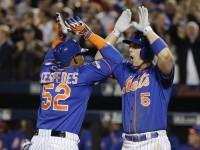
No one anywhere will suggest that a team’s Spring Training record is indicative of anything. In fact, statistics and results shouldn’t be over analyzed. With that said, there are some results from Spring Training that can reasonably be cause for alarm.
deGrom’s Velocity
Last year, Jacob deGrom‘s fastball averaged 95.81 MPH. This Spring, deGrom’s fastball has generally been between 91 – 93 MPH.
There are reasons for this. He took additional time off in the offseason with last year’s increased workload. He dealt with a minor leg injury. He had to get a new mattress because the old one gave him a stiff back. His wife is expecting and may deliver any day now. Overall, there have been a series a distractions and very minor injuries. Through it all, he hasn’t found his fastball.
Now, deGrom can probably still get people out with less stuff, but it’s not ideal. With a slower fastball, he can still be good, but he won’t be dominant. He may find his fastball in real games whether it is due to velocity or him holding something back in Spring Training. However, as of today, he is throwing 91-93 MPH, and Spring Training is effectively over. It’s fair to be concerned about deGrom’s velocity.
Cespedes’ Power
When Yoenis Cespedes came to the Mets, he put on a display. Up until 2015, he averaged 24 homers a year. In two months with the Mets, he hit 17 home runs.
This Spring he has hit one homerun. He has been working with Kevin Long to change his approach at the plate. He’s had stiffness in his hip. In the NLCS, he had to pull himself from a game with an aggravated AC joint in his right shoulder. That same right shoulder has been bothering him this Spring.
Now, Cespedes is a streaky hitter who can start hitting home runs all over the place once the season begins. His one homerun came in the last Spring Training game, which is hopefully a sign of good things to come. However, at this point, we cannot dismiss the possibility that the decreased power is from this new approach, or his wonky right shoulder, or both.
Bastardo’s Control
With Antonio Bastardo, there are two issues you have with him: (1) he pitches well every other year; and (2) walks.
For starters, based upon the pattern of Bastardo’s career, he will have a rough 2016. In even numbered years, his ERA+ has been under 100 and his ERA has been 3.94 and above. In odd numbered years (where he played a full season) his ERA+ is 129 and above, and his ERA has been 2.98 and below. As we know, this is an even numbered year, and his Spring hasn’t instilled any confidence that the pattern will change.
One big reason why is Bastardo has walked 5 guys in 10.1 innings this Spring. Both Terry Collins and Dan Warthen are worried about his command. Warthen has been working with Bastardo on his mechanics to no avail. It’s a problem that needs to be fixed because Bastardo has walk issues. In his career, he averages 4.1 BB/9 (not good) in odd numbered years. In the dreaded even years, he averages 4.7 BB/9 (worse). Right now, Bastardo has given no indication this odd year – even year pattern won’t continue.
Conforto Hasn’t Played RF
Right now, the Mets have five outfielders capable of playing everyday. Of those five, Curtis Granderson, Alejandro De Aza, and Juan Lagares have platoon splits. Last year, Michael Conforto was only allowed to face righties the vast majority of the time.
The plan for Conforto this year was to let him play everyday. Having Conforto play everyday and not play in RF is going to be difficult. When the Mets face a lefty, especially a tough lefty, it’s likely Collins will want Lagares in CF and Cespedes in RF. That means the left-handed batter will have to play RF. In that circumstance, Collins will be more likely to play Granderson or De Aza as both have experience in right field.
For his part, Conforto hasn’t played right field in his very limited time as a professional. He’s worked there during practices in Spring Training, but he has not played right field in a game. There is simply no substitute for in-game experience. It’s likely the lack of game experience may hold him back. It’s likely Collins will not play Conforto in right.
By not playing Conforto against lefties, they may be hampering his development. Furthermore, the Mets may not be putting their best lineup out there against lefties.
David Wright’s Back
To be fair, when David Wright returned from the DL last year, he hit .277/.381/.437 in 30 games. If Wright can keep that up – he’s a career .298/.377/.492 hitter – there’s no reason to be concerned about him. Even better, he had a full offseason to adequately prepare for 2016.
However, Wright had trouble playing three games in a row after his return from spinal stenosis. It wasn’t until this week that Wright dared to play four games in a row in Spring Training. At the end of the day, no one knows how many games Wright can play in 2016. Everything is in estimate or a guess whether it be 130, 100, 81, 10, etc. That’s a problem.
Wright is the Mets’ captain. He’s the best option at third base. He’s still a good hitter who gets on base more than anyone else in the lineup. Whether the Mets or anyone else will acknowledge it, the team needs him. Unfortunately, no one knows how much Wright can give them.
Overall, there are things about this Spring that should give Mets fans cause for concern. The record isn’t one of them. It’s not the production. It’s the team’s general health and preparedness for the 2016 season.
Despite these issues, the Mets still look to be a great team that can not only compete for a playoff berth, but also win the World Series.
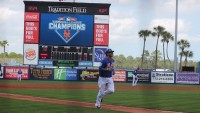
What a difference a year makes. This time last year, Juan Lagares was coming off a 5.5 WAR season and a Gold Glove. There was discussion about him being the leadoff hitter in 2015. He seemed to be ready to take the next big step in his career.
Instead, Lagares regressed in every aspect of his game. His epic defense noticeably slipped. His batting average, on base percentage, and slugging percentage dropped. Eventually, he forced the Mets to trade for an outfielder at the trade deadline. A player that was supposed to have a breakout year became a platoon player and a late inning defensive replacement.
The Mets tried to trade Lagares at the deadline. The initial plan was to sign Alejandro De Aza to play a platoon with Lagares. When it became apparent the Mets could sign Yoenis Cespedes on a short term deal, they moved to get that done. That makes Lagares a fourth outfielder, at best, and a defensive replacement in 2016. Apparently, he has an untradeable contract.
That begs the question of what will be Lagares’ future with the Mets?
As noted in 2016, it will be as a bench player and late defensive replacement. Beyond that is anyone’s guess. Will he be able to build off a strong postseason? Will his elbow heal sufficiently enough to permit him to throw better in the outfield and/or swing the bat better? The Mets hope the answer to all these questions is yes.
Cespedes has an opt out after this year, and he could be out the door after this season. Curtis Granderson is only signed through 2017. Furthermore, he’s going to be 35 by Opening Day. Who knows if Brandon Nimmo will ever become a major leaguer let alone a starting outfielder? Also, as noted, Lagares may have an untradeable contract. He’s due to make $4.5 million in 2017, $6.5 million in 2018, and $9.0 million in 2019.
Personally, I’m still high on Lagares. He showed a lot in the postseason. He should be able to become the best defensive center fielder in baseball again. He’s got another year to work with Kevin Long to see if he can help Lagares maximize his offensive abilities.
Lagares is going to get his chances this year. He should play in almost every game to provide late inning defensive help. He should get starts against lefties allowing Granderson or Michael Conforto a day off. So yes, Lagares will be a bench player in 2016, but he will also have plenty of opportunities to improve. He will have plenty of opportunities to show the Mets he’s an important part of the Mets’ future.
Hopefully, this year, Lagares will take that step forward we were all hoping he would take last year.

It is surreal to think it was only 12 years ago that David Wright was walking into Mike Piazza‘s clubhouse. Now, with Piazza being retired, it’s now Piazza’s turn to walk into Wright’s clubhouse:
For the Twitter folks: David Wright welcomes Mike Piazza to #Mets camp on Sunday morning: pic.twitter.com/Yq9k7jLkxz
— Adam Rubin (@AdamRubinMedia) February 28, 2016
Back then, everyone on the team knew how good Wright was going to be. They saw him as their best chance of ever winning a World Series. They all took him under their wing.
Piazza mentored Wright how to handle New York and how he should listen to his body. In he following Spring Training, Carlos Beltran took Wright with him for extra workouts to show him the type of off-the-field work is needed to succeed in the major leagues. Cliff Floyd took him under his wing. Not only did he have Wright carry his luggage, he also showed him how to be a big leaguer.
It’s now Wright’s turn to return the favor. Seeing the Noah Syndergaard lunch incident last Spring, he appears ready, willing, and able. Now, it worked with Syndergaard because he was a player that wanted to get better.
There are still plenty of young Mets players who could learn a lot from Wright. Each of these players should be glued to Wright’s hip learning as much as they possibly can from him. Like Piazza, Beltran, and Floyd, Wright can teach these players how to handle New York, how to listen to your body, how to prepare for a season, and how to be a big leaguer. The one player who j think can most benefit right now from Wright’s wisdom is Michael Conforto.
Conforto is in the same spot Wright once was. He’s on a team with great players. Success in the majors seemingly came easy to him in his first half season. If the Mets do anything going forward, it’s going to be his bat that’s going to be a big part of it. He’s also still young with a lot to learn.
Like David Wright all those years ago, we all see greatness in Michael Conforto. Wright should be helping Conforto prepare himself not just for this season, but for his entire career. Helping Conforto could be the key to Wright getting that elusive World Series ring. Listening to Wright could be the key to Conforto having a long and successful Mets career. They need each other.
Who knows? Maybe 12 years from now, we will get to see Conforto welcoming a retired Wright into his clubhouse.
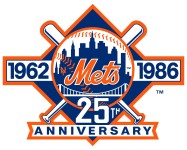
Yesterday, the Mets announced that the Mets will wear the iconic 1986 racing stripe jerseys every Sunday home game this season. I love these jerseys, but it does seem odd that the team is wearing these jerseys each and every Sunday.
The Mets everyday left fielder, Michael Conforto, was born on March 1, 1993. At that time, the only members of the 86 Mets still around were Dwight Gooden and Howard Johnson. Gooden’s Mets career was effectively over at that point. He was a shell of his former self due to drug abuse and injuries. HoJo was only a utility player on the 86 team. The main contribution he made that year was being the on deck batter when Ray Knight scored off of Mookie Wilson‘s little dribbled up the first base line.
It seems odd to me to see Conforto wearing a 25th anniversary patch that was created for a team seven years before he was born.
Again, if the Mets want to do this, they should do it right. Update the patch to commemorate the 30th anniversary of the 1986 World Series championship. This way it truly becomes an homage to the 1986 team that it was intended to be. Furthermore, the jerseys will look more appropriate when you purchase them.
Speaking of purchasing one, which I intend to do, there are two problems with the jerseys. The first is the diaper effect of the jerseys:
The next is if you don’t want the diaper, you don’t get the patch, nor do you get the option to personalize it:

One last note, am I the only one that thinks it’s going to look absurd to see Tim Teufel effectively wearing Darryl Strawberry‘s jersey?
Overall, I love that these jerseys are back. I think the Mets were smart making them the Sunday jerseys. I hope they return in 2017. I just wish they were updated to be the tribute the Mets wanted them to be.
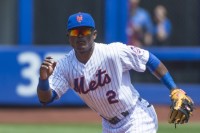
After the Mets make a decision at catcher, the team appears like they will have between $82 – $96 million to build a roster and re-sign their pitching.
Looking at the roster, the Mets will need to obtain starters at the following positions: 1B, 2B, SS, and RF. David Wright is scheduled to make $15 million, so whether or not you believe he will be able to stay at the position, he will remain with the team in some capacity. Michael Conforto should still be with the team as the leftfielder. Finally, unless the Mets can move him, Juan Lagares and his $9 million salary will be the team’s centerfielder. The Mets organization is fairly well stocked with position players right now, and they might be able to fill out the roster with cheap, cost-controlled talent.
First Base
Somewhat controversely, Keith Law named Dominic Smith the 29th best prospect in all of baseball. He’s the first baseman of the future.
Accordingly to the scouting reports, Smith is a good defensive first baseman that should be able to hit. The debate really is whether he will hit for power. Whether or not he hits for power, people see him as being able to field the position and be a good major league hitter.
With Lucas Duda being a free agent in 2018, the Mets will need Smith to be ready. If he’s not ready, the Mets will need a stopgap. In either event, by the time the Mets pitchers start to become free agents, Smith should be the first baseman earning around $500,000.
Second Base
We have to assume that one of these years Dilson Herrera is going to transition from second baseman of the future to the Mets second baseman. With Neil Walker only having one year until free agency, it appears that time will be 2017.
Right now, Herrera has less than one year’s service time. For all the supposed newfound depth, it’ll probably be Matt Reynolds getting called up to the Mets. That will preserve his service time. It means that in 2019, Herrera should be the second baseman, and he will have accrued two full years service time. Unless he gets enough playing time, it appears like he will avoid Super Two status meaning he will be in the same $500 – $600 thousand range as Smith.
Shortstop
As far as organizational depth, the Mets seemingly have an embarassment of riches with two high end shortstop prospects with Gavin Cecchini and Amed Rosario. They also have the aforementioned Reynolds.
Given Asdrubal Cabrera‘s contract, Cecchini and Rosario are going to have time to develop on the minors. At a minimum, Cabrera is signed to be the Mets shortstop through the 2017 season. If he produces well, or the prospects need another year, Cabrera has an option that could keep him with the Mets through the 2018 season.
As such, neither Cecchini or Rosario will be arbitration eligible at the time the Mets pitchers start to reach free agency. Accordingly, the Mets will only have to spend around $500 thousand when the pitchers begin to become free agents.
Left Field
It seems Michael Conforto is the leftfielder of the past (2015), present, and future. He very well should be too. Even if Conforto doesn’t improve upon his 162 game averages he achieved as a 22 year old, who never played above AA, you’re getting a good defensive outfielder who will hit .270/.335/.506 with 26 homers and 75 RBI.
Fortunately, Conforto will not have accrued enough service time to achieve Super Two status. Unfortunately, Conforto will most likely become arbitration eligible the same time that the Mets pitchers are reaching free agency.
Looking over the past few years, there isn’t really a good comparable to Conforto. It seems that when teams have good young corner outfielders, they lock them up. With that in mind, although an admittedly imperfect comparison, J.D. Martinez is instructive.
In 2014, Martinez was 26 years old, and he hit .325/.358/.553 with 23 homers and 76 RBI in 123 games. He became arbitration eligible after this season, and he agreed to $3 million. In 2015, he had another good year hitting .282/.344/.535 with 38 homeruns and 102 RBI. He and the Tigers avoided an arbitration hearing. Martinez’s contract extension bought out the remainder of his arbitration years he’s due to make $6.75 million in 2016 and $11.75 million in 2017.
While we may or may not agree on whether Martinez is a good comparable, it would be fair to say Conforto is at least capable of hitting .272/.344/.535 by his age 25 season, if not sooner. If that’s the case, it would be fair to suggest Conforto could earn anywhere from $3 – $6 million in his first year of eligibility.
Right Field
Curtis Granderson‘s contract will expire after the 2017 season. Since he will be 37 heading into the 2018 season, it’s hard to imagine he will be re-signed to be the everyday right fielder.
Now, Wuilmer Becerra projects to be an everyday player. Scouts believe he has the bat to play the corner outfield spot. The issue as far as the Mets are concerned is how quickly the 21 year old minor leaguer will need before fulfilling that promise. Last year, Becerra played his first year in full season A ball. That’s a long trek to the majors by 2019.
So unless Brandon Nimmo can handle the corner outfield offensively, which unfortunately seems unlikely, the Mets will have to look outside the organization to fill that void.
If Becerra is still a well regarded prospect, the Mets are likely to bring in a player on a one to two year deal. In retrospect, depending on how he finishes out his contract, Granderson could be coaxed back on a one-year deal ata much lower contract price.
As a placeholder, let’s presume the cost of a right fielder would cost about $15 million. That’s what Granderson is slated to earn the last year of his contract.
Cost of the Projected 2019 Starting Lineup
If everything breaks right for the Mets, they will have a group of young, cost-controlled position players at the time their starting pitchers hit the free agent market. If this pans out, the Mets everyday position players would cost about $46.5 million.
That’s roughly what the Mets are paying their current starting infield. In total, the 2016 Mets starting lineup is due to be paid roughly $90 million. Essentially, the Mets will be spending half the amount of money on their starting lineup in 2019 than they will this season.
Overall, this leaves the Mets between $35.5 – $49.5 million to build a bench, a bullpen, and to pay their starting rotation if the payroll remains stagnant at the $140 million range.
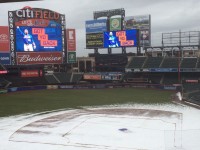
Am I the only one that finds it incredibly fitting that Yoenis Cespedes is being introduced during a rainy day? Remember, it might’ve been a rainy day that brought him here in the first place.
Roughly half a year ago, there was some hope in the Mets season. The team had just acquired Tyler Clippard, Kelly Johnson, and Juan Uribe. Michael Conforto was up with the team and producing well ahead of schedule. Travis d’Arnaud was soon to return. While Mets fans had seen some bad baseball for far too long, things were seemingly getting much better. Then disaster struck.
There was the inexplicable drama surrounding the failed Carlos Gomez trade. Wilmer Flores was left standing on the field crying. Then we discover the trade didn’t happen. The Mets say Gomez failed a physical. The Brewers said the Mets wanted money in the deal. With all that hovering, the Mets took the field for a rainy day game. They had a 7-1 lead going into the seventh, and a 7-5 lead heading into the ninth. The Padres had two outs and Jeurys Familia had an 0-2 count on Derek Norris.
The heavens opened causing the umps to call a rain delay for a game that could’ve ended with one more pitch. The delay nearly lasted an hour. When they game resumed Familia allowed a single to Norris, another single to Matt Kemp, and then a three run homer to one-time trade target Justin Upton. After another rain delay of around two and a half hours, the game resumed seeing the Mets go down meekly 1-2-3 in the ninth. Whatever good feelings and momentum in the season was there, it was seemingly washed away. The fans were angry.
The rains eventually cleared. There would be a new day both literally and metaphorically when the Mets pulled the trigger on the trade for Yoenis Cespedes. Sure the Mets win the NL East without him, but man, the 2015 season had a different feel to it when he came on board. It was a fun run, and now he’s back. We’re ready for another ride.
But first, he’s going to be re-introduced to the fans on a rainy day. Seeing how it was a rainy day that brought him here, I wouldn’t have it any other way.
Welcome back Cespedes.
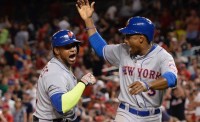
Right now, there are two people who are realistically standing in the way of Yoenis Cespedes returning to the Mets. No, it’s not Fred and Jeff Wilpon. It’s Michael Conforto and Curtis Granderson.
Like it or not, Sandy Alderson was right when he said Cespedes isn’t a centerfielder. While Cespedes grades out as an elite leftfielder, he’s just not good in center. Last year, he had a -3.2 UZR and -4 DRS while playing center. For his career, his UZR in center is -12.6, and his DRS there is -17. While the Mets were willing to move him in and out of center to take advantage of platoon splits for Juan Lagares while not forcing Conforto to face lefties. While it was rough at times, it did seem to work.
However, that was over the course of three months. Cespedes’ defensive numbers in center are unsustainable over a full season. I don’t buy the argument he only needs to play there two years. He’s already established he shouldn’t be playing there now. No, if the Mets want to re-sign him, he needs to go either left or right. That begs the question, why haven’t the Mets made room for him?
Specifically, I’m asking why the Mets haven’t explored trading Granderson. Last year, Granderson hit .259/.364/.457 with 26 homers and 70 RBI from the leadoff spot. He was a finalist for the Gold Glove in rightfield. On a team where everyone was dropping like flies, he played 157 games, and really, he was the only credible major league bat in the lineup for far too long stretches of time. His 5.1 WAR ranked him as a top five rightfielder in all of baseball last year. He has a reasonable two years $31 million remaining on his contract. One way of looking at this is saying he’s too valuable to be traded.
Another is to say he’s at his peak value, which is the precise time you want to trade players. Granderson is a year removed from a .237/.326/.338 campaign. The year before that he hit .229/.317/.407. He had pronounced splits last year hitting .183/.273/.286 against lefties and .280/.388/.504 against righties. His 5.1 WAR last year was the highest it had been since 2011. He’s going to be 35 on Opening Day next year.
Right now, the Mets still project to have Eric Campbell make the Opening Day roster until they sign another 1B/OF. The Mets still talk about adding another reliever. Their farm system took a big hit last year. Couldn’t trading Granderson address one, two, or all three of these needs? Isn’t that what smart front offices do? Don’t they trade away a player a year too early rather than a year too late?
Also keep in mind,this is a heavy left-hand hitting team. Trading Granderson and re-signing Cespedes would balance that out a bit. Isn’t this something worth exploring?
Personally, I’d like to see the Mets keep Granderson. I’m a big fan of his on and off the field. With that said, trading Granderson now may be the right thing to do. His value won’t be any higher, and the Mets have some needs to address. The Mets do not want to be paying for Granderson during his possible decline.
It might be time to trade Granderson.
Editor’s Note: this article first appeared on metsmerizedonline.com

